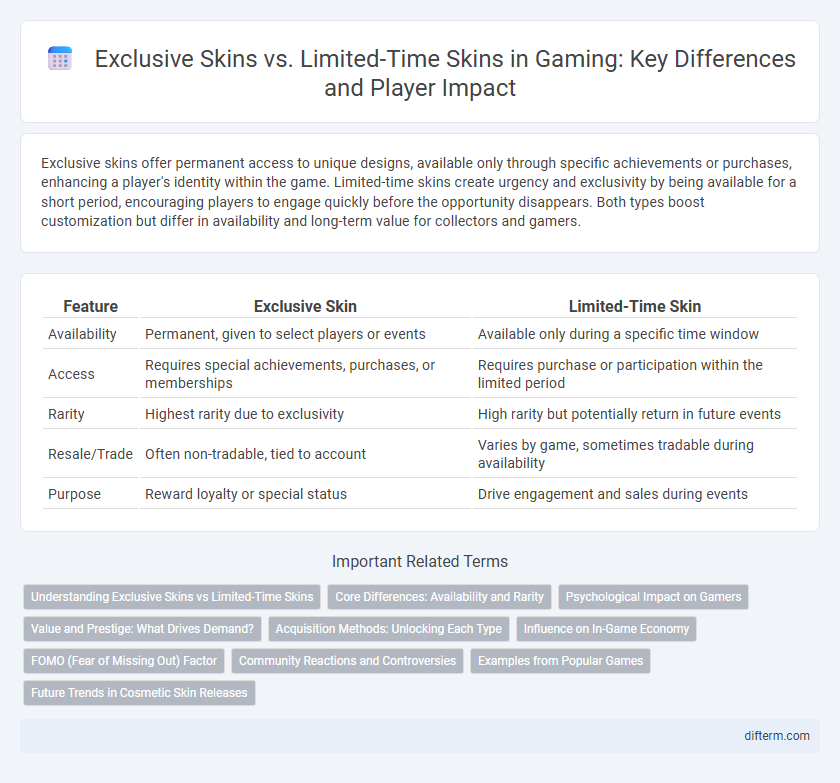Exclusive skins offer permanent access to unique designs, available only through specific achievements or purchases, enhancing a player's identity within the game. Limited-time skins create urgency and exclusivity by being available for a short period, encouraging players to engage quickly before the opportunity disappears. Both types boost customization but differ in availability and long-term value for collectors and gamers.
Table of Comparison
| Feature | Exclusive Skin | Limited-Time Skin |
|---|---|---|
| Availability | Permanent, given to select players or events | Available only during a specific time window |
| Access | Requires special achievements, purchases, or memberships | Requires purchase or participation within the limited period |
| Rarity | Highest rarity due to exclusivity | High rarity but potentially return in future events |
| Resale/Trade | Often non-tradable, tied to account | Varies by game, sometimes tradable during availability |
| Purpose | Reward loyalty or special status | Drive engagement and sales during events |
Understanding Exclusive Skins vs Limited-Time Skins
Exclusive skins in gaming offer unique customization options tied to special achievements, events, or purchases, providing players with prestige and rarity. Limited-time skins are available only during certain periods or events, creating a sense of urgency and encouraging timely participation. Understanding the difference helps players strategize collection priorities and enhances the overall gaming experience.
Core Differences: Availability and Rarity
Exclusive skins are permanent rewards tied to specific achievements or events, offering players unique customization that remains accessible indefinitely. Limited-time skins are available only during special promotions or seasonal events, creating a sense of urgency due to their temporary availability. The core difference lies in availability--exclusive skins are permanently attainable, whereas limited-time skins are rare collectibles that vanish after the event ends, impacting their rarity and player demand.
Psychological Impact on Gamers
Exclusive skins foster a sense of pride and identity by signaling status and dedication to a game, often boosting player loyalty. Limited-time skins create urgency and fear of missing out (FOMO), motivating immediate engagement and increased spending. Both skin types exploit psychological triggers to enhance player investment and emotional connection to the game.
Value and Prestige: What Drives Demand?
Exclusive skins hold higher value due to their rarity and permanent availability to select players, enhancing prestige through sustained uniqueness. Limited-time skins create urgency and exclusivity by appearing briefly, driving demand via scarcity and the fear of missing out. Players prioritize exclusive skins for long-term status while limited-time skins capitalize on timely appeal and event-driven exclusivity.
Acquisition Methods: Unlocking Each Type
Exclusive skins are typically acquired through special achievement unlocks, event participation, or direct purchase in premium bundles, ensuring they remain rare and highly sought-after by players. Limited-time skins, on the other hand, are available only during specific periods, often obtained via time-restricted events, seasonal challenges, or promotional codes, creating urgency for players to secure them before they disappear. Both acquisition methods impact player engagement by encouraging timely participation and rewarding dedication with unique cosmetic items.
Influence on In-Game Economy
Exclusive skins often drive higher in-game currency value by creating scarcity that encourages player investment and trading, boosting virtual market demand. Limited-time skins, available only during specific events, generate spikes in economic activity as players rush to acquire rare assets before expiration. Both types influence supply and demand dynamics, but exclusive skins tend to sustain long-term economic impact due to their permanent rarity.
FOMO (Fear of Missing Out) Factor
Exclusive skins offer players permanent rarity and status, often tied to special achievements or events, intensifying the FOMO factor as missing them means losing out forever. Limited-time skins heighten urgency with a strict availability window, compelling players to act quickly or face permanent loss, fueling immediate engagement. Both types strategically leverage scarcity to boost player motivation and emotional investment in gaming communities.
Community Reactions and Controversies
Exclusive skins often spark mixed reactions in gaming communities, with players appreciating their rarity but criticizing the perceived paywall, which can create divisions between free and paying users. Limited-time skins generate urgency and excitement but frequently lead to frustration over missed opportunities and difficulty in obtaining desired items. Both types of skins provoke controversies regarding fairness, accessibility, and the impact on player inclusivity.
Examples from Popular Games
Exclusive skins in popular games like Fortnite's "Black Knight" or Overwatch's "Doomfist's Oni" are unlockable only through specific achievements or purchases, making them permanently inaccessible after the event ends. Limited-time skins, such as League of Legends' "Pulsefire Ezreal" or Apex Legends' seasonal "Holo-Day Legends," are available only during designated events or seasons, incentivizing players to participate within a constrained timeframe. The rarity and availability of these skins drive player engagement and create a sense of urgency, enhancing game monetization strategies.
Future Trends in Cosmetic Skin Releases
Exclusive skins often remain permanently tied to special events or achievements, maintaining long-term rarity and increasing player desirability, while limited-time skins capitalize on urgency and seasonal themes to boost immediate engagement. Future trends indicate a blend of these models, with developers leveraging advanced AI customization and player-driven design contests to create dynamically evolving, limited-availability cosmetics. This approach enhances personalization and market longevity, fueling sustained in-game economies and community involvement.
Exclusive Skin vs Limited-Time Skin Infographic

 difterm.com
difterm.com